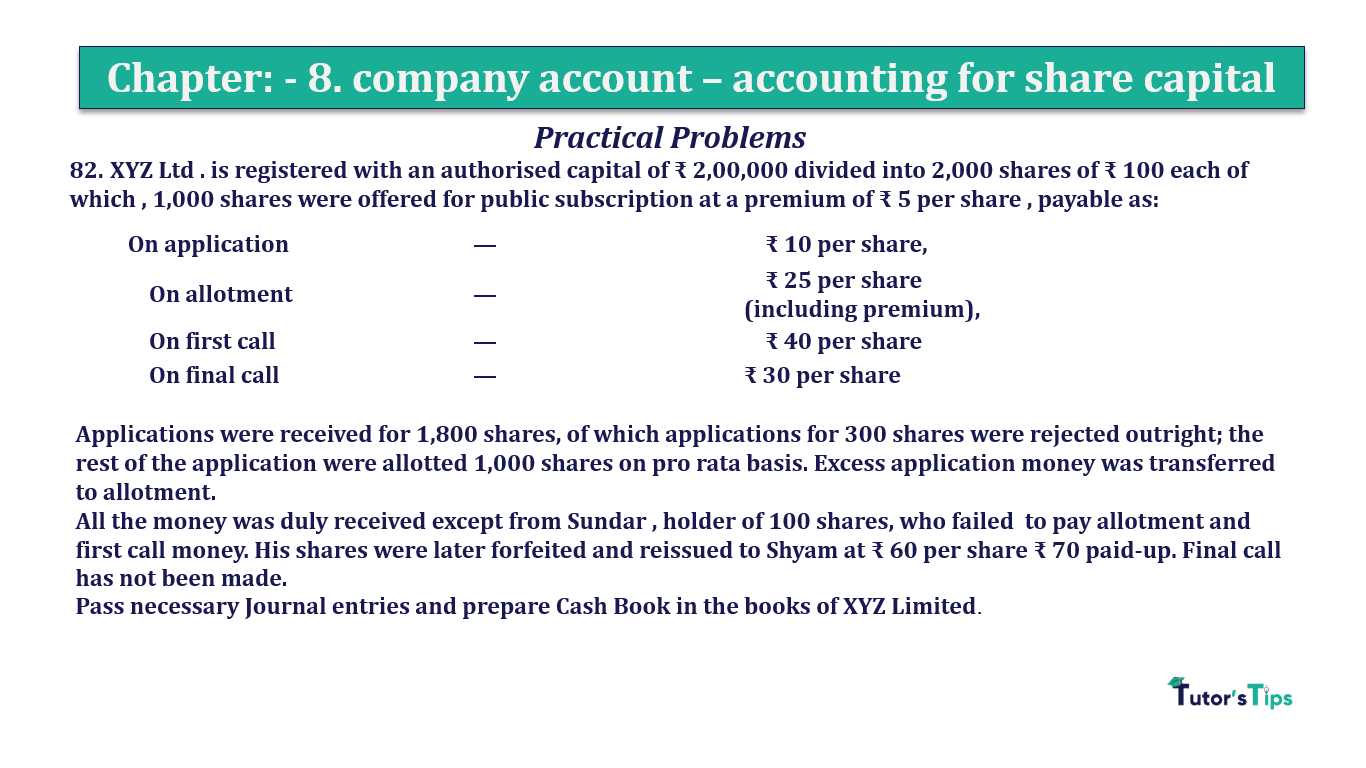Question 82 Chapter 8 of +2-A
82. XYZ Ltd . is registered with an authorised capital of ₹ 2,00,000 divided into 2,000 shares of ₹ 100 each of which, 1,000 shares were offered for public subscription at a premium of ₹ 5 per share, payable as:
| On application | — | ₹ 10 per share, |
| On allotment | — | ₹ 25 per share (including premium), |
| On the first call | — | ₹ 40 per share |
| On final call | — | ₹ 30 per share |
Applications were received for 1,800 shares, of which applications for 300 shares were rejected outright; the rest of the application were allotted 1,000 shares on a pro-rata basis. Excess application money was transferred to the allotment.
All the money was duly received except from Sundar, holder of 100 shares, who failed to pay allotment and first call money. His shares were later forfeited and reissued to Shyam at ₹ 60 per share ₹ 70 paid-up. A final call has not been made.
Pass necessary Journal entries and prepare Cash Book in the books of XYZ Limited.
The solution of Question 82 Chapter 8 of +2-A: –
| Date | Particulars |
L.F. | Debit | Credit | |
| Share application A/c | Dr | 15,000 | |||
| To Share capital A/c | 10,000 | ||||
| To Share allotment A/c | 5,000 | ||||
| (Being application money transferred to equity share capital ) | |||||
| Share allotment A/c | Dr | 25,000 | |||
| To Share capital A/c | 20,000 | ||||
| To Securities premium A/c | 5,000 | ||||
| (Being the allotment money due ) | |||||
| Share first and final call A/c | Dr | 40,000 | |||
| To Share capital A/c | 40,000 | ||||
| (Being first call due ) | |||||
| Securities premium A/c | Dr | 500 | |||
| Equity share capital A/c | Dr | 7,000 | |||
| To Equity share forfeiture A/c | 1,500 | ||||
| To Share allotment A/c | 2,000 | ||||
| To Share first call A/c | 4,000 | ||||
| (Being the share forfeited ) | |||||
| Share forfeiture A/c | Dr | 500 | |||
| To capital Reserve A/c | 500 | ||||
| (Being the gain on reissue transferred to capital reserve ) | |||||
| Date |
Particulars |
J.F. | Bank |
Date |
Particulars |
J.F. | Bank |
| To equity share application a/c | 18,000 | By equity share application a/c | 3,000 | ||||
| To equity share allotment a/c | 18,000 | ||||||
| To equity share first, call a/c | 36,000 | ||||||
| To equity share capital a/c | 6,000 | By Balance C/d | 75,000 | ||||
| 78,000 | 78,000 |
Working notes –
| Number of Shares applied by sunder | = | 1,500 | * 1,000 | = | 150 shares |
| 1,000 |
| On Account of sunder | 1,500 |
| Money received on application (150 * Rs 10) | (1,000) |
| Excess Money on application | 500 |
| Share allotment due (100 * Rs 25) | 2,500 |
| Less; Excess Money on application | (500) |
| Calls – in-Arrears application | 2,000 |
| Allotment | |
| Allotment due on all shares 1,000 * Rs 25 | 25,000 |
| Less; Adjustment of excess money on application | (5,000) |
| Less; calls –in- Arrears by Sunder | (2,000) |
| Money received on the allotment | 18000 |
Capital reserve
Capital reserve = share forfeiture (cr.) – Share forfeiture (dr.)
=1500 – 1,000= Rs 500
Advertisement-X
Please Like and share with your friends
Comment if you have any question.
Also, Check out the solved question of previous Chapters: –
T.S. Grewal’s Double Entry Book Keeping +2 (Vol. I: Accounting for Not-for-Profit Organizations and Partnership Firms)
- Chapter No. 1 – Financial Statement of Not-For-Profit Organisations
- Chapter No. 2 – Accounting for Partnership Firms – Fundamentals
- Chapter No. 3 – Goodwill: Nature and Valuation
- Chapter No. 4 – Change in Profit-Sharing Ratio Among the Existing Partners
- Chapter No. 5 – Admission of a Partner
- Chapter No. 6 – Retirement/Death of a Partner
- Chapter No. 7 – Dissolution of a Partnership Firm
T.S. Grewal’s Double Entry Book Keeping (Vol. II: Accounting for Companies)
- Chapter No. 8 – Company Accounts – Accounting for Share Capital
- Chapter No. 9 – Company Accounts – Issue of Debentures
- Chapter No. 10 – Redemption of Debentures
T.S. Grewal’s Double Entry Book Keeping (Vol. II: Accounting for Companies)
- Chapter No. 1 – Financial Statements of a Company
- Chapter No. 2 – Financial Statement Analysis
- Chapter No. 3 – Tools of Financial Statement Analysis – Comparative Statements and Common- Size Statements
- Chapter No. 4 – Accounting Ratios
- Chapter No. 5 – Cash Flow Statement
Check out T.S. Grewal +2 Book 2020@ Official Website of Sultan Chand Publication








Leave a Reply